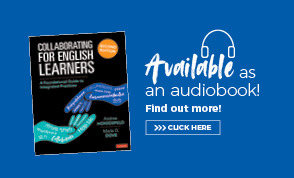Collaborating for English Learners
A Foundational Guide to Integrated Practices
But this, we promise: when EL specialists and general ed teachers pool their expertise, your ELs’ language development and content mastery will improve exponentially. Just ask the tens of thousands of Collaboration and Co-Teaching users and now, a new generation of educators, thanks to this all-new second edition: Collaborating for English Learners.
Why this new edition? Because more than a decade of implementation has generated for Andrea Honigsfeld and Maria Dove new insight into what exemplary teacher collaboration looks like, which essential frameworks must be established, and how integrated approaches to ELD services benefit all stakeholders. Essentially a roadmap to the many different ways we can all work together, this second edition of Collaborating for English Learners features:
- All-new examples, case studies, illustrative video, and policy updates
- In-depth coverage of the full range of strategies and configurations for determining the best model to adopt
- Templates, planning guides, and other practical tools to put collaboration into practice
- Guidelines, self-assessments, and questionnaires for evaluating the strategies’ effectiveness
Free resources
Companion Website: Collaboration for English Learners
Access a wealth of videos and other resources connected to each chapter of Collaborating for English Learners.
One of the biggest dilemmas that every educator experiences is how to teach all of our students- especially when so many come from cultural and linguistic experiences that are distinct from our own. Honigsfeld and Dove bring to light the positive possibilities of working together. This new edition of their foundational book provides a refreshing look at collaboration. Backed by new research-based evidence, voices from the field, and their superb writing, they demonstrate how co-teaching and collaboration makes it possible for English learners to be successful in school and their lives. Whether you are new to the profession or a seasoned veteran, it’s filled with powerful ideas, strategies and protocols that you can be put to use immediately.
Authors of teaching books have their niche expertise. Some are gurus in project-based learning, technology integration, or inquiry learning to name a few topics. Honigsfeld and Dove are undoubtedly the leaders of teacher collaboration. They synthesize their decades of research and field experience into clear, actionable suggestions for all teachers who are seeking to have effective, positive collaboration partnerships. This is THE guide if teachers want to know who benefits from teacher collaboration, what are the different forms of collaboration, how to collaborate, when to collaborate, and why teachers might consider collaborating. Teachers new to collaborating, administrators who want to support the collaborative relationships, and experienced educators who want to teach collaboratively will be well served by this definitive guide.
When building your infrastructure of collaboration and co-teaching, it is imperative to equip both teachers and leaders on successful and sustainable partnerships and environments to produce equitable access to education. Without knowing the elements of the infrastructure to co-teaching it is inevitable that the system will return to singleton lead teacher classrooms, leaving accessibility and equitable access to core behind for ALL students. This text is imperative to those on the collaborative journey; whether just beginning, advancing, or re-imagining a current co-teaching framework or integrated services for ELs. Honigsfeld and Dove never cease to amaze me!
Collaborating for English Learners: A Foundational Guide to Integrated Practices is a great follow-up to the first edition of the book as well as Dr. Dove’s and Dr. Honigsfeld’s recently published Co-Teaching for English Language Learners.
Teachers and administrators will find this book a great asset in implementing or enhancing a co-teaching service delivery model for ELs. Readers will appreciate the consistency of the text. Title chapters and overviews enable the reader to choose their reading journey. The discussion questions at the end of each chapter make it ideal for Professional Learning Communities as they promote deep conversations which enhance both teachers’ and administrators’ understanding of collaborative integrated services for ELs.
As a former principal and present mentor, I highly recommend this book for a book study as it provides a framework for educators to talk about their teaching practices and by working together ensures academic success for all learners.
"Collaborating for English Learners: A Foundational Guide to Integrated Practices, Second Edition comes at a critical time as educators seek guidance on how to skillfully integrate language and content standards and curriculum, and implement collaborative practices serving our multilingual students. Honigsfeld and Dove provide not only the most current research foundations, but also very practical strategies that teachers and school leaders can immediately implement. These strategies are further supported with compelling case studies and implementation frameworks that will leverage, support and sustain collaboration transformations in your daily work. Honigsfeld and Dove’s expertise and experience shared in this Second Edition is tried, true and trusted because it is informed by their deep and sustained experiences over time, right in schools, digging deep into collaborative practice with teachers and school leaders. This resource is a must-add to your PLC discussions, professional learning plans and school and district improvement planning!"
"This second edition of Collaborating for English Learners has all the practical advice of the original resource, now updated with current research, voices from the field, alignment to today’s best practices and much more. If you or your staff are veterans of co-teaching, you’ll appreciate the specific advice for working with language learners and the opportunities to reflect on how we are serving these students. If you’re an administrator or teacher who is new to the model, you’ll find answers to questions about collaboration and a clear path for moving toward healthy, productive co-teach partnerships for the sake of English learners. "


